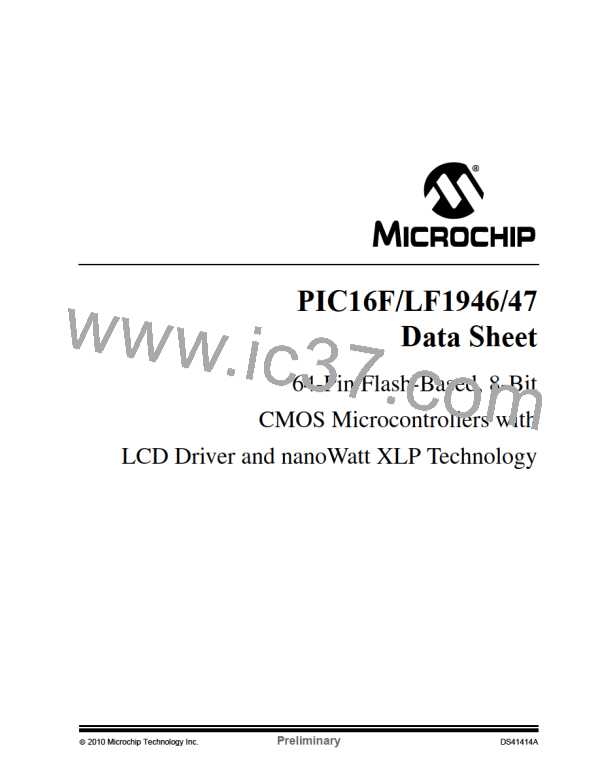PIC16F/LF1946/47
The Full-Bridge mode does not provide dead-band
delay. As one output is modulated at a time, dead-band
delay is generally not required. There is a situation
where dead-band delay is required. This situation
occurs when both of the following conditions are true:
22.4.2.1
Direction Change in Full-Bridge
Mode
In the Full-Bridge mode, the PxM1 bit in the CCPxCON
register allows users to control the forward/reverse
direction. When the application firmware changes this
direction control bit, the module will change to the new
direction on the next PWM cycle.
1. The direction of the PWM output changes when
the duty cycle of the output is at or near 100%.
2. The turn off time of the power switch, including
the power device and driver circuit, is greater
than the turn on time.
A direction change is initiated in software by changing
the PxM1 bit of the CCPxCON register. The following
sequence occurs four Timer cycles prior to the end of
the current PWM period:
Figure 22-13 shows an example of the PWM direction
changing from forward to reverse, at a near 100% duty
cycle. In this example, at time t1, the output PxA and
PxD become inactive, while output PxC becomes
active. Since the turn-off time of the power devices is
longer than the turn-on time, a shoot-through current
will flow through power devices QC and QD (see
Figure 22-10) for the duration of ‘t’. The same
phenomenon will occur to power devices QA and QB
for PWM direction change from reverse to forward.
• The modulated outputs (PxB and PxD) are placed
in their inactive state.
• The associated unmodulated outputs (PxA and
PxC) are switched to drive in the opposite
direction.
• PWM modulation resumes at the beginning of the
next period.
See Figure 22-12 for an illustration of this sequence.
If changing PWM direction at high duty cycle is required
for an application, two possible solutions for eliminating
the shoot-through current are:
1. Reduce PWM duty cycle for one PWM period
before changing directions.
2. Use switch drivers that can drive the switches off
faster than they can drive them on.
Other options to prevent shoot-through current may
exist.
FIGURE 22-12:
EXAMPLE OF PWM DIRECTION CHANGE
(1)
Period
Period
Signal
PxA (Active-High)
PxB (Active-High)
Pulse Width
PxC (Active-High)
PxD (Active-High)
(2)
Pulse Width
Note 1: The direction bit PxM1 of the CCPxCON register is written any time during the PWM cycle.
2: When changing directions, the PxA and PxC signals switch before the end of the current PWM cycle. The
modulated PxB and PxD signals are inactive at this time. The length of this time is four Timer counts.
DS41414A-page 222
Preliminary
2010 Microchip Technology Inc.

 MICROCHIP [ MICROCHIP ]
MICROCHIP [ MICROCHIP ]